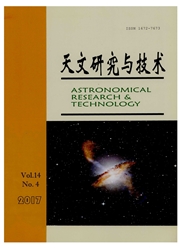

 中文摘要:
中文摘要:
在空间碎片监测领域,漫反射激光测距技术具有更广泛的应用前景。目前,漫反射激光测距处于试验阶段,仅靠单台设备获得的短弧测距数据难以实现目标定轨,这制约了漫反射激光测距技术的应用。根据轨道理论,如果在测距的同时,能够提供目标的切向约束,可显著提高目标定轨的成功率和可靠性。提出激光测距和光学测角一体化技术的方案,以上海天文台60cm激光测距望远镜系统为基础,通过增加短焦距、大视场的光学照相设备,建立一套激光测距与光学测角一体化的试验平台,并以Ajisai卫星为目标开展了观测。现阶段试验目的为,考察一体化观测的可行性,评估测角精度。结果表明,激光测距与光学测角一体化技术方案可行,ajisai卫星的测角精度达到5″。
 英文摘要:
英文摘要:
In monitoring space debris the technology of diffuse reflection laser ranging has more potential applications than traditional laser ranging technologies. At present, this technology is still in an experimental stage so that the orbits of objects can hardly be determined only using ranging data from a single station. This restricts its applications. According to the theory of orbit determination the success rate and reliability of orbit determination can be improved substantially if constraints on the tangential motion of an object are available during its laser ranging measurement. We hereby present a scheme of observation integrating diffuse reflection laser ranging and object direction measurement. We have made a test system of the scheme by installing a photographic equipment with a short focal length and a large field of view to the 60cm satellite laser ranging telescope system of the Shanghai Astronomical Observatory. We carried out experimental observations with the system by choosing the satellite Ajisai as the object. The purpose of the experimental observations is to examine the feasibility of the scheme and assess the accuracy of direction measurement. The results show that the scheme is feasible and the accuracy of direction measurement for the satellite Ajisai reaches 5 arcseconds.
 同期刊论文项目
同期刊论文项目
 同项目期刊论文
同项目期刊论文
 期刊信息
期刊信息
